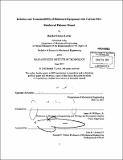Isolation and transmissibility of shipboard equipment with carbon fiber reinforced polymer mount
Author(s)
Lewis, Rachel Taylor
DownloadFull printable version (4.573Mb)
Other Contributors
Massachusetts Institute of Technology. Dept. of Mechanical Engineering.
Advisor
James H. Williams, Jr.
Terms of use
Metadata
Show full item recordAbstract
The isolation and transmissibility of shipboard equipment is important to the function of a ship. The transmission of vibration from an engine to its surroundings can be devastating to sensitive equipment and disrupt normal operations. Isolator pads can be used to dampen transmissions from equipment to the ship and vice versa. In this thesis isolator pads of three different materials were considered: carbon fiber reinforced material (CFRP), steel, and rubber. These isolator pads were paired with two pieces of equipment. The first was a marine diesel engine with a relatively large mass and internal rotation. The second piece of equipment was an electronic chart display and information system (ECDIS) with a relatively small mass and no rotating parts. The rubber isolator pad was not a good isolating pad compared to either CFRP or steel, which had comparable responses to impulse and step inputs as well as transmissibility or isolation. For the marine diesel engine the steel isolator pad was marginally better, while the CFRP was best for the ECDIS.
Description
Thesis (S.B.)--Massachusetts Institute of Technology, Dept. of Mechanical Engineering, 2012. Cataloged from PDF version of thesis. Includes bibliographical references (p. 47).
Date issued
2012Department
Massachusetts Institute of Technology. Department of Mechanical EngineeringPublisher
Massachusetts Institute of Technology
Keywords
Mechanical Engineering.